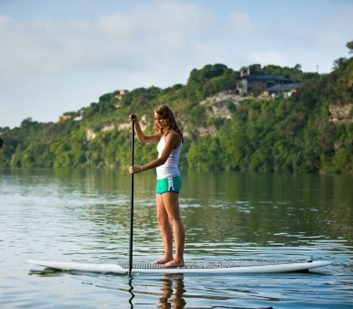Stand-up paddleboarding: How to get started
Want to learn this fun, new water sport? Jessica Rando, a Toronto-based fitness trainer and certified SUP instructor, shares her stand-up paddleboarding tips

Source: Best Health magazine, Summer 2013; Image: Thinkstock
How do I learn to stand-up paddleboard?
A one- to two-hour lesson (usually $35’$75) will cover the basics. And while it’s a fairly low-risk sport, learning correct form means you’ll be less likely to hurt your shoulders or neck while you paddle. Will you fall off? Maybe once or twice, depending on your balance and the choppiness of the water, but most recreational boards are wide and stable. Visit Paddle Canada at paddlingcanada.com to find a certified instructor and a list of classes across Canada.
What’s the right paddleboarding technique?
Your instructor will show you how to start out kneeling on the board and how to stand up. Stand with your knees soft, feet hip-width apart. The basic paddle stroke is like canoeing: To move to the right, paddle on the left, with your right hand at the top of the paddle and your left hand lined up below.
What do I need to try stand-up paddleboarding?
Most people prefer bare feet and a swimsuit or workout gear, although cold water demands extra clothing and sometimes even a wetsuit. Transportation Canada considers a SUP a human-powered vessel and requires that you have a personal flotation device (PFD) with you if you are out of the surf zone, as well as a whistle and flashlight. Use a PFD designed for paddling, which has cutouts around the shoulders. Other requirements include a leash worn around your ankle to connect you to the board, and a light affixed to the board if you’re out around dusk or dawn.
How much does it cost to try stand-up paddleboarding?
Board and paddle rentals are usually about $25 an hour. A new, entry-level board ranges from $800’$1,500, while a paddle is $70’$150. They are sold at major sporting goods stores that sell other watercraft, and can be rented at most places where lessons are offered. Choose a board that will hold the heaviest person who is going to use it’the board should float on the water, without water coming over the sides. Recreational flatwater boards are between 10 and 12 feet long, and are wide and stable. Paddles should be about 10 to 12 inches taller than you are, and the ones used for SUP surfing or paddling in waves are generally shorter than paddles used for paddling in flatwater.
This article was originally titled "What’s SUP?" in the Summer 2013 issue of Best Health. Subscribe today to get the full Best Health experience’and never miss an issue!




